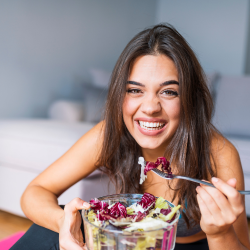Affiliate Disclosure: This blog may receive a small commission at no extra cost to you, for purchases made via affiliate links. If you decide to support our blog in this way, I thank you!
100% of plant foods contain one or more nutrients (vitamins and minerals), and Micro-nutrients (the plant chemicals that have been shown to prevent and/or reduce cancers, increase circulation, reduce cholesterol and blood pressure, and to perform a whole host of other hefty benefits for the body). Consequently, eating a wide variety of fruits, vegetables, beans and whole grains is always great for your overall health.
However, in choosing “the best” foods for this list, I focused on skin health as well as the number of benefits each food provides. In other words, some plant foods have a slightly better overall profile for good skin than others.
That said, eat whole, colorful plant foods in variety and abundance and you’re bound to have good skin. (I am pro-vegan and all but two foods are vegan.) Now, on with the list!
BERRIES
Better than any argument is to rise at dawn and pick dew-wet red berries in a cup.
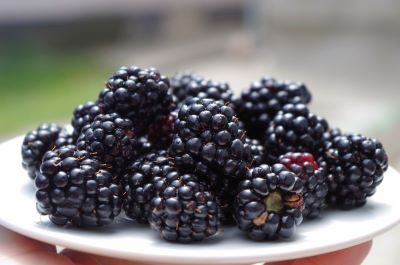
Blackberries
Be Springy
WHAT MAKES THEM DIFFERENT? Blackberries have the most fiber (along with raspberries) of any other berry: 8 grams per cup. Fiber aids digestion and lowers cholesterol as well as blood sugar levels. AGEs (Advanced Glycation End Products) arise when sugar binds with protein and leads to collagen degradation. Keeping blood sugar balanced helps to protect the collagen and elastin tendrils that keep skin bouncy and lifted.
In addition, blackberries are full of *polyphenols which are potent antioxidants that reduce inflammation and improve blood circulation, leaving your skin glowing. Last but not least, blackberries also have the most protein of any berry, with 2 grams per cup.
*According to webmd.com Studies show that polyphenols are powerful antioxidants. In this role, they prevent or reverse damage in your cells caused by aging, the environment, and your lifestyle.

Blueberries
Build Collagen
WHAT MAKES THEM DIFFERENT? All berries have antioxidants, but blueberries (also called bilberries) have the highest antioxidant capacity of all. Not only does this enormous combination of antioxidants protect the skin from cell damage, but it also encourages the skin’s fibroblast cells, to develop more collagen and increases your skin’s ability to heal itself. This is thought to be from the high content of anthocyanins (which give them their blue hue).
During World War II, British Royal Air Force Pilots noticed that their vision was better at night when they ate blueberry jam. Blueberries were later shown in EUROPEAN studies to have a positive effect on eyesight, possibly due to their support in the rebuilding of healthy connective tissue. Blueberries, like blackberries, also increase circulation and improve blood flow, keeping arteries flexible. They are thus being studied to prevent Alzheimer’s Disease, as Alzheimer’s is thought to be perhaps a vascular disease. And hey they’re delicious too!

Raspberries
Get Rosy
WHAT MAKES THEM DIFFERENT? Raspberries contain Rutin, which is a flavonoid that builds capillaries (also in the white pith of grapefruit). Eat them for stronger skin that can facilitate better blood flow and a rosier complexion.
A cup of raspberries contains 50% of the daily recommended intake of Vitamin C. They are also rich in manganese, Vitamin K and other antioxidants. As mentioned above, raspberries also contain a whopping 8 grams of fiber per cup. I love the sweet yet tangy flavor of raspberries. For a topical treat, try this moisturizing organic red raspberry seed oil, by Berry Beautiful.
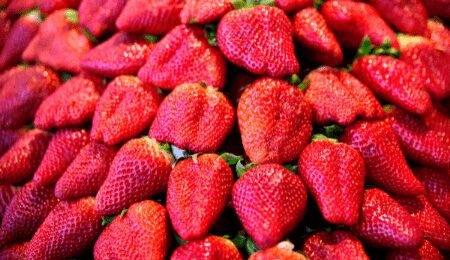
Strawberries
Brighten
The beautiful strawberry has the highest concentration of vitamin C of all the berries: 150% of the RDA in just one cup! Vitamin C is essential in the building of collagen.
WHAT MAKES THEM DIFFERENT? Strawberries also contain the highest concentration of any fruit or vegetable of Fisetin, which is a compound that clears out dead (senescent) cells. In doing so, it enables your skin cells to work more efficiently and will help your complexion to look its best. Strawberries also lighten dark spots with Ellagic Acid, & can be used in face masks for this purpose. For more information on the benefits of Strawberries, see What do Kiwi, Strawberries, Banana and Walnuts do for your Skin?
FERMENTED FOODS

Kimchi
Get Radiant
I don’t think it’s a coincidence that Koreans are known for their beautiful skin. Kimchi is a dish they eat daily with meals, that offers a pungent contrast to cooked foods, has probiotics to help digestion, and adds fiber to the diet.
WHAT MAKES IT DIFFERENT? The glowing skin benefits come from the fermented garlic and abundance of spices like cayenne and ginger.
Garlic helps reduce cholesterol and the spices increase circulation, resulting in that healthy glow! The fermentation concentrates the vitamins in the food and the enzymes aid absorption. Kimchi is also an antioxidant powerhouse which protects your skin from the DNA damage that causes skin to age. I recommend adding celery to your kimchi in order to dissipate the garlic breath. See here for a no-fuss, authentic Kimchi Recipe.
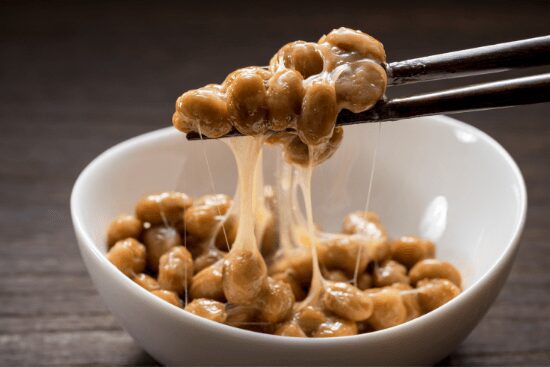
Natto
Re-Model
Natto is a staple of the Japanese diet, made of fermented soybeans.
WHAT MAKES IT DIFFERENT? Natto is loaded with vitamin K2.
In 2008, Korean researchers showed that a diet high in vitamin K2 led to smoother skin features in women.
The body needs vitamin k2 in order to aid calcium into the bone where it is needed, and out of the bloodstream. This aids in maintaining strong bone structure (think cheek bones). Our diets are sorely lacking vitamin k2.
Studies also show the bacteria used to ferment natto helps the skin build hyaluronic acid.
And…with its abundance of other vitamins and minerals natto is a no-brainer for healthy skin.
If you want to try natto and you don’t live next door to a Japanese grocery, try this SMALL BEAN ORGANIC NATTO, Made in Vermont by Rhapsody Natural Foods.
For more on natto, see 7 Best Foods for Firm Skin.

Yogurt
Exfoliate
WHAT MAKES IT DIFFERENT? Yogurt is not only a great source of protein, but it also contains lactic acid, vitamin B and probiotics. Protein is an essential ingredient for tissue repair throughout our bodies, including our skin. Vitamin B helps increase blood flow to the skin. Probiotics improve gut health which in turn aids the body to extract the most nutrition from foods. Topically the lactic acid exfoliates the skin, shrinks pores and creates a glow from the cell turnover. Its Anti-bacterial, anti-fungal and hydrating properties also make yogurt a great addition to a facial cream or mask. Caveat: Make sure to keep it organic to ensure humane farming and for the healthiest, hormone-free yogurt.
To try yogurt in your skincare, pick up this Nourishing Pro-Biotic Gel-Cream, by Korres.

Sauerkraut
Renew Cells
WHAT MAKES IT DIFFERENT? Sauerkraut is a good option for people who can’t tolerate the spiciness of Kimchee. It is a fermented cabbage condiment popularized in Germany, rich in Vitamin A, sulfur, antioxidants and probiotics. Eating more Vitamin A can help prevent wrinkles as it encourages cell turnover. Sauerkraut’s high sulfur content can add a rosy glow to your skin, as it encourages circulation. The probiotics benefit your gut to reduce skin inflammation, a common source of premature aging. Sauerkraut can be high in sodium so it may not be the best option for anyone with cardiovascular or renal issues. Eat it with your favorite veggie hot dog with spicy mustard for a German meal! For some more great information on all things sauerkraut, see the blog makesauerkraut.com.
Live in each season as it passes: breathe the air, drink the drink, taste the fruit.
~Henry David Thoreau
FRUITS

Apricots
Shield from Damage
WHAT MAKES THEM DIFFERENT? Like carrots, Apricots contain significant amounts of Vitamin E, beta carotene (which converts to Vitamin A in the body), B vitamins, and potassium. Apricots however, also have 69% more Vitamin C than carrots. Vitamin E is particularly effective when combined with vitamin C to prevent free radical damage to cells. Since Vitamin A is key in regulating cell growth, it may have a positive effect on slowing skin cancer cells.
Vitamins A and C support the creation of collagen and elastin, while the fiber aids the gut to utilize nutrients well and lower inflammation. Apricots also contain fatty acids for skin moisture. When eaten whole (NOT dried) they are also relatively low in sugar, which is good since sugar causes inflammation and glycation. Altogether the humble apricot carries a healthy punch for the complexion and is delicious to boot!

Kiwi
Repair
WHAT MAKES THEM DIFFERENT? Kiwi are amongst the fruit with the lowest sugar content, while they have the highest amount of vitamin C to build collagen. They also have Zinc which helps to build collagen, and that great antioxidant team vitamin C with vitamin E to provide DNA protection from the sun. And not to be ignored, they contain the antioxidant Quercitin, which has been proven to sustain inter-cellular communcation.
All this may add up to the reason behind this study, cited by Dr. Michael Greger of Nutritionfacts.org, that concludes there’s something (a yet-unknown mechanism) about kiwi which has the ability to regenerate broken DNA strands – and that means in our skin as well as throughout our bodies. Great news for people who love kiwi!
For supple skin, I recommend this very basic and affordable Kiwi Seed Oil from Chateau Cosmetics Botanical Beauty. There are a lot of great skin oils out there but this one soaks into my skin so well and gives me that dewy look without the shine. Must be the magic of kiwi again!

Tomatoes
Protect from sun
WHAT MAKES THEM DIFFERENT? Tomatoes (when cooked) have the highest amount of the potent antioxidant LYCOPENE of any other food. Lycopene is a carotenoid that research has shown to have anti-cancer properties. It also protects against UV rays. In addition, tomatoes contain Vitamins E and C which have anti-inflammatory properties to slow down aging. Topically, the enzymes in tomatoes have exfoliation benefits, making tomatoes a great ingredient in a homemade facial mask.
Lycopene is best absorbed with oil (and heated or cooked) so enjoy tomatoes in a delicious tomato sauce!
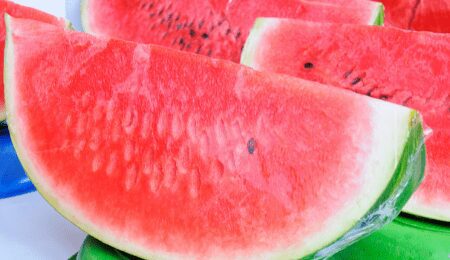
Watermelon
Plump
WHAT MAKES IT DIFFERENT? Watermelon contains the amino acid CITRULLINE, which produces nitric oxide which relaxes blood vessels and improves circulation.
This increase in blood flow has all kinds of skin-enhancing benefits, including better color and faster healing.
Aside from being hydrating on a hot day, watermelon is also a good dietary source of vitamins C and E, and lycopene (though not as good as from cooked tomatoes.) Its combination of antioxidants provide a degree of internal protection from sun damage.
Watermelon rind is used in Korea as a topical treatment for redness and inflammation, and is a common ingredient in many hydrating topical products. I eat watermelon when I want to feel healthy and when I want my skin to glow!
For a topical treat, try this popular Watermelon Glow Sleeping Mask, by Glow Recipe.
GRAINS
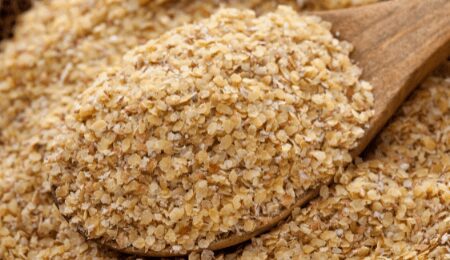
Wheat Germ
Shine
Wheat germ is the part of the wheat kernel that helps to spawn new wheat, and is usually removed from wheat products, however it’s the most nutritious component.
WHAT MAKES IT DIFFERENT? Wheat germ contains phytosterols that have been shown to lower blood cholesterol levels, a good thing for keeping arteries clear so oxygen can flood easily to the skin.
It is high in Vitamin E, Zinc, Magnesium, Fiber and B vitamins.
At 20 milligrams per tablespoon or 135% of your daily value, wheat germ oil is the most concentrated natural vitamin E source. Vitamin E wards off inflammation and has anti-oxidant properties to help maintain skin’s youthful appearance. In fact, vitamin E is particularly important in protecting fat-containing organs from DNA damage, like our skin!
Wheat germ oil can also be applied topically and is used to treat acne, dark spots, dryness and eczema. As always, choose organic.
Sprinkle a couple tablespoons of wheat germ on your yogurt or oatmeal for a delicious nutty flavor addition.
There’s no such thing as soy milk. It’s soy juice.
~Lewis Black
LEGUMES & BEANS
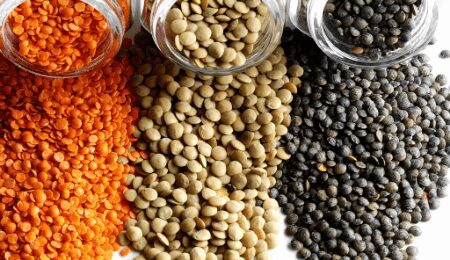
Lentils
Strengthen
WHAT MAKES THEM DIFFERENT? Lentils are second only to soybeans in terms of protein, and when combined with a whole grain, they can provide the same quality of protein as meat. Lentils also have iron, zinc, fiber and B vitamins. Protein and zinc are crucial for strong collagen and elastin. The Vitamin E prevents inflammation and early aging of the skin. The soluble Fiber also absorbs sugars in the blood to prevent glycation that causes the breakdown of collagen and elastin.
Cook them with vegetables like carrots and tomatoes to also benefit from the vitamin A and Lycopene in the vegetables. My grandfather used to call them “the poor man’s meat,” but I feel rich and satisfied when I eat them. Make a delicious lentil soup and enjoy!
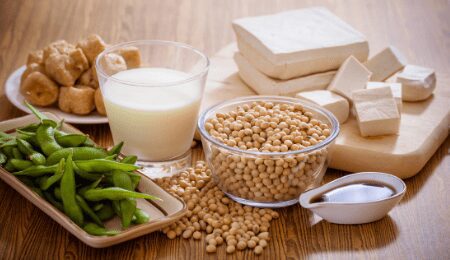
Soy Foods
firm up
As I’ve talked about in a couple of my other articles, soy foods (when organic) are extremely healthful for the body and the skin, even though they are misunderstood.
WHAT MAKES IT DIFFERENT? Soy contains a high content of Isoflavones and Phytoestrogens. The isoflavones help to build strong collagen and elastin to keep skin firm, and the phytoestrogens protect cells from toxic xeno-estrogens in the environment and keep hormones balanced. Soy is rich in protein and best eaten fermented. Avoid highly processed soy powders and nuggets and instead enjoy tempeh, miso, natto, tofu, and soymilk.
NUTS & SEEDS

Almonds
Be Bouncy
Almonds are delicious nuts that offer protein, the B vitamins riboflavin and niacin, as well as 50% of the RDA of vitamin E for antioxidant protection.
WHAT MAKES THEM DIFFERENT? They also have a good balance of zinc and copper for firmness. Together, zinc and copper play a key role in strengthening collagen: crucial for elasticity. The healthy fat in almonds, Alpha Linoleic Acid, contributes to soft skin. UC Davis has conducted studies that show a significant improvement in facial skin aging with the addition of almonds to the diet.
Keep raw, unsalted almonds around to eat when you need a skin-healthy snack.

Sunflower Seeds
Moisturize
WHAT MAKES THEM DIFFERENT? Sunflower seeds contain pectin, a type of fiber that aids the body to eliminate radiation. This in turn prevents the rogue free radicals from damaging skin cells and giving you age spots and sagging.
Sunflower seeds also have the most vitamin E of any NUT OR SEED, to moisturize skin from the inside and protect it from the UV rays of the sun.
Vitamin E can be used topically for the same effects. (I like to pop it out of a capsule at night, and mix it with almond oil, but you can buy prepared formulas as well: less messy that way)! Sunflower seeds are high in copper for firm skin, selenium, and phosphorus. Add a handful of raw, unsalted, shelled seeds to your salads for delicious crunch!
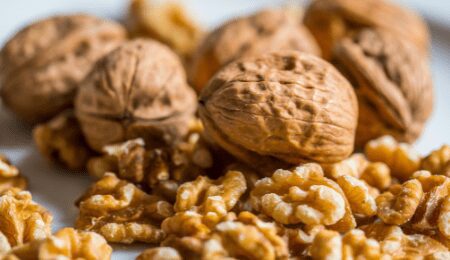
Walnuts
glisten
WHAT MAKES THEM DIFFERENT? According to a study cited by the NIH, after testing the gamut of nuts, Walnuts had the highest free and total polyphenols in both the combined raw and roasted samples.
In addition, thanks to their exceptional combination of Omega-3 Fatty Acids (ALA), Fiber, Vitamin E, and Protein, Walnuts top the list for nuts that will soften, smooth, and soothe your skin. Walnuts also improve endothelial function, which means your capillaries remain pliable and better able to provide your skin with oxygen-filled blood.
Omega-3 fatty acids help to strengthen the skin’s barrier, keeping toxins out and locking moisture in. They can also help to reduce skin irritation and protect against UV rays. You can eat 14 walnut halves for a good dose of ALA daily, at just 185 calories. I add them to sauteed vegetables, salads, oatmeal, or just eat them as a snack.
Walnut oil is also a great topical ingredient that can help ward off fungal infections, and reduce the appearance of wrinkles. It can also be added to a soothing bath to help treat psoriasis.
Wherever Flaxseeds become a regular food item among the people, there will be better health.
~ Mahatma Gandhi
HEALTHY FATS

Salmon
Rejuvenate
Salmon provides an abundance of Omega-3 fatty acids DHA and EPA for skin hydration and dewiness.
WHAT MAKES IT DIFFERENT? It also contains Astaxanthin, which is a powerful carotenoid antioxidant found in sea algae that prevents sunburn and adds a rosy hue to the skin, among other benefits. A 2012 study showed that taking oral astaxanthin supplements combined with topical application lead to a noticeable improvement in wrinkles, texture, and sunspots. (Be careful to choose sustainably farmed or wild salmon, not Atlantic farmed that has added food coloring as they feed grains to the fish instead of algae as in the wild.)
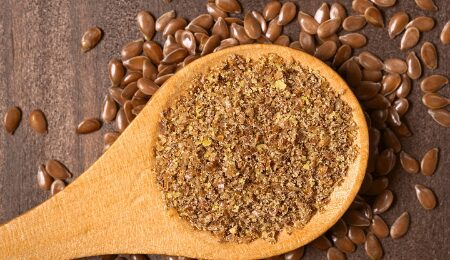
Flaxseed
Soften
We’ve talked about the benefits of Omega-3 Fatty Acids for skin.
WHAT MAKES IT DIFFERENT? Ground Flaxseed prevails amongst plant foods for the highest content of ALA Omega-3 fatty acid, at 6.5 grams per ounce. Just one tablespoon of flax oil contains 7.5 grams of ALA, exceeding the daily requirement. Studies show that women who ate just half a tablespoon of flax oil daily showed a 39% increase in skin hydration, with less redness and irritation. In addition to skin benefits, ground flaxseed does the body good by reducing cholesterol due to the fiber content, and balancing hormones. The hormonal adjustments seem to block disruptive estrogens that might otherwise cause cancer.
I like flaxseed oil on salads, oatmeal, and to top off a bowl of soup. Delicious as it is, I will put it on anything! It needs to stay refrigerated and never cooked in order to preserve the fatty acids. Ground flaxseed is great in smoothies, to take advantage of the fiber. See more on Flaxseed in my article Delicious Oat/Buckwheat Pancakes.
Life Expectancy would grow by leaps and bounds if green vegetables smelled as good as bacon.
~Doug Larson, Cartoonist
VEGETABLES

Beets
Glow
Beets are chockful of vitamins and minerals, protein and fiber. They contain vitamin C, folate, vitamin B6, magnesium, potassium, phosphorous, manganese and iron.
WHAT MAKES THEM DIFFERENT? In addition, beets contain large amounts of nitrates which are converted to nitric oxide in the body. Nitric oxide facilitates the flow of blood throughout the body and can add to the skin’s glow. Beets have antioxidants called betalains, which give them their bright purple color and protect its skin (and ours) from the skin-ravaging effects of the sun. Enjoy them regularly in salads!
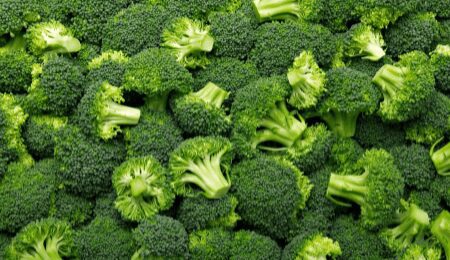
Broccoli
stop skin cancer
WHAT MAKES IT DIFFERENT? You might have heard that broccoli is a nutritional powerhouse, containing a huge amount of nutrients like fiber, vitamin C, vitamin K, iron, and potassium. But do you know that it has the potential of preventing and possibly reversing cancer?
Studied for decades but just currently gaining traction, is the substance Sulforaphane, found abundantly in broccoli (and to a lesser extent in all cruciferous vegetables and leafy greens.)
According to comprehensive studies, cited by the NIH:
Note: The healthiest way to eat broccoli is raw, however If you prefer to cook your broccoli, add a sprinkle of mustard seed. This will unlock the full potential of sulforaphane, making it easier for your body to absorb the important phytochemical.
For more information on broccoli and a broccoli soup recipe, see my article: Why is broccoli so good for your skin?
Do you enjoy any of these skin-healthy foods? Let me know in the comments section below!
For a quick and easy salad recipe that uses some of these foods, See my SALAD RECIPE FOR CANCER PREVENTION




